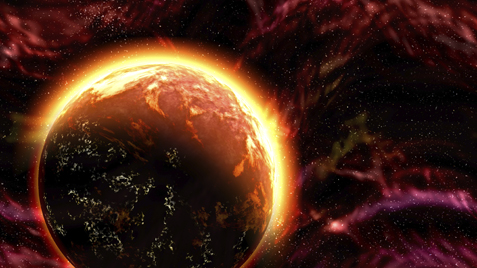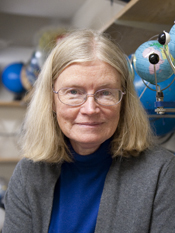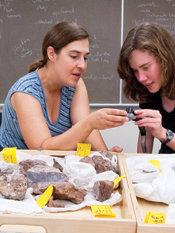

Though they may see the subject through different empirical lenses, when an astronomer and a paleontologist posit their projections for predicting the end of the planet, they find that they unequivocally agree on one point: through scientific observation and timely response, humankind can subvert catastrophic events that would mean death for life on Earth.
/ Published April 15, 2011
Looking toward the heavens and deep into the earth, astronomy and geoscience—disciplines, well represented at Smith—take on an issue many might prefer to disregard: predicting and addressing the future demise of our planet.
From their respective fields, Suzan Edwards, L. Clark Seelye Professor of Astronomy, and Sara Pruss, assistant professor of geosciences, describe several scenarios regarding the end of the planet. Though the two scientists see the subject through different empirical lenses, on one point they unequivocally agree: through scientific observation and timely response, humankind can subvert catastrophic events that would mean death for life on Earth.
Astronomy and its painstaking methods of observation allow us to posit these sorts of projections, Edwards explains. “There are 100 billion stars in the galaxy—stars of all different ages. We map out how stars die. We go back and forth between theory and observations until we can nail down, with great confidence, what we are seeing and what we can expect from our own sun.”
Edwards sees the Earth as currently situated in a moment of cosmological fortune for the life it supports. “Right now, the Earth is just the right distance from the sun, given the sun’s luminosity and radiation into space,” she explains. “Earth is in this so-named habitable zone; Venus is too close to the sun, and Mars is too far from it.”
However, the sun is going to change. “It will grow steadily more luminous, emitting 10 percent more radiation between 1 and 2 billion years from now,” Edwards predicts. “The Earth will overheat and the oceans will evaporate, causing a runaway greenhouse effect. Finally, the atmosphere will burn off altogether, turning the Earth into a cinder.”
As if that weren’t grim enough, in approximately 5 billion years, “the sun will essentially run out of ‘fuel,’ lacking enough hydrogen in the core to continue the nuclear reaction that currently sustains it,” Edwards continues. “The core will collapse and heat up, pushing the outer part of the sun out. In this bloated, ‘red giant’ phase, the sun will literally engulf the Earth.”
Nevertheless, Edwards is optimistic, citing developments in human technology as the key to our survival. “We know that it’s going to happen; there’s no question. But there are all kinds of things that one can do. For instance, as the sun increases in luminosity and approaches the red giant phase, other planets farther out in the solar system will become more habitable. So there is opportunity to move. We can relocate.”
Edwards even suggests that if we didn’t want to switch planets, we could essentially turn the Earth into a spaceship. “We could change the orbit of the Earth over time and locate it further from the sun,” she offers. “The power that would be required is beyond our capacity at the moment, but we’re not far from being able to generate that kind of technology.”
By contrast, Sara Pruss—a paleontologist and sedimentologist—focuses on understanding how life has evolved through time and how it has fared through mass extinction events.
For Pruss, a careful examination of the geologic past is a look into the future. “What we have in the geologic record is a much longer scope of time. We have billons of years at our fingertips,” Pruss explains. “So given what we know about the past, we are driven to form hypotheses about what’s going on behind today’s environmental events and offer predictions for the future.”
Regarding the popularity of any particular explanation for potential human extinction, Pruss is loath to offer a singular answer. “I don’t know that there is any one theory,” she explains. “It could be any number of things—disease, war, climate change resulting in massive famine.”
However, climate change—anthropogenic or otherwise—deserves our attention, Pruss argues, since it will happen much sooner than the astronomic changes projected by Edwards. “There is going to be global climate change on some level, and it is likely to cause a certain amount of chaos and instability, particularly as our population and need for resources grow.” If we respond inadequately, she argues, “it seems like that could set the stage for a situation—like a domino effect—that could ultimately lead to the demise of humankind.”
That notwithstanding, Pruss is confident in the ability of humans to adapt quickly to a changing world. “We are the most globally dominant species that has ever lived on this planet. I don’t think that climate change is insurmountable. We have more control than we ever have, in terms of being able to predict, outlast and survive major events on our planet.”
Although humans demonstrate a capacity for adaptive survival, “it is naïve to say that we are mere observers of this planet’s cycle,” Pruss asserts. “Whether we take negative actions such as overfishing and over farming or positive ones such as reining in consumption and monitoring our carbon footprint, there is no way that humans are not, somehow, going to play a role in the unfolding of the future of the planet.”
Be it by watching the stars or sifting through sediments, scientific observation allows us to make predictions, narrow down possibilities and act preventatively in assuring our own future. As Pruss puts it, “We can use it all as a lesson for our future survival. We’re not mollusks that live in the ocean. We can innovate.”
For the latest news on Assistant Professor of Geosciences Sara Pruss’ research into what planet Earth was like some 700 million years ago, visit MIT’s Web site.

















